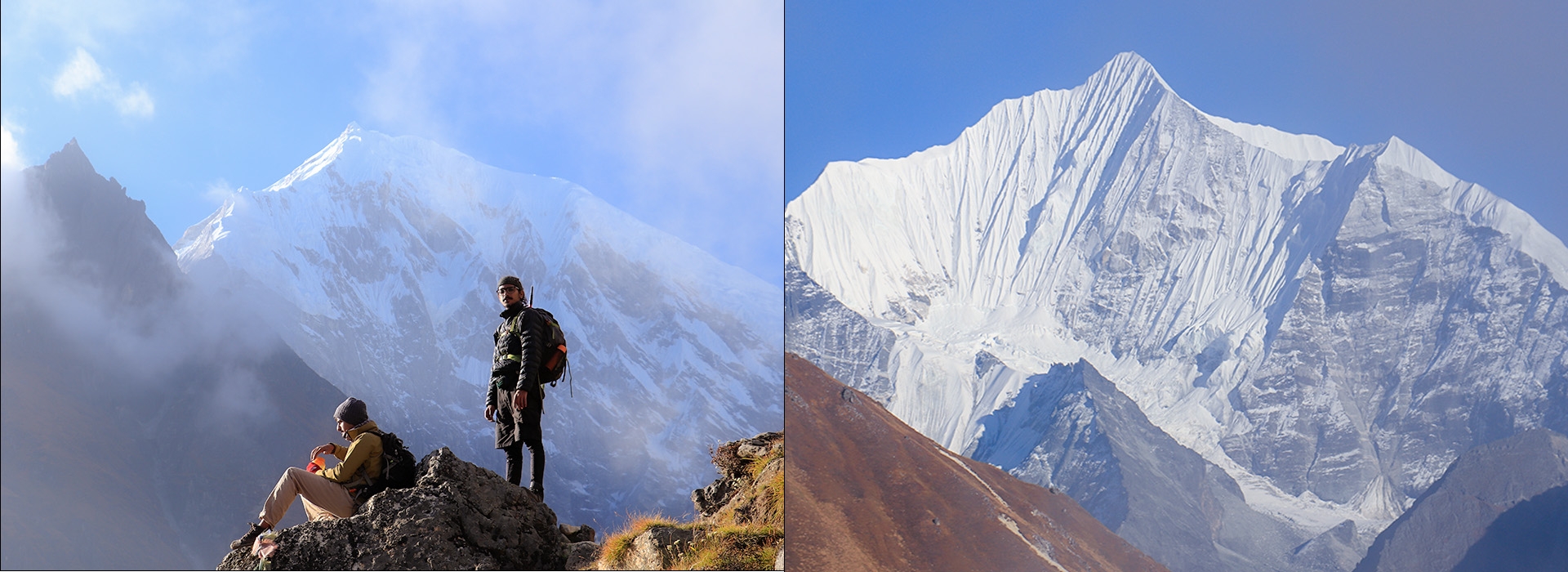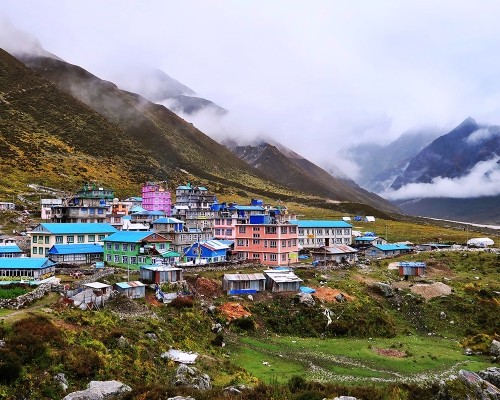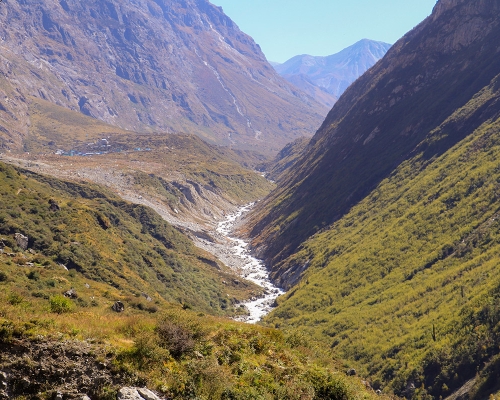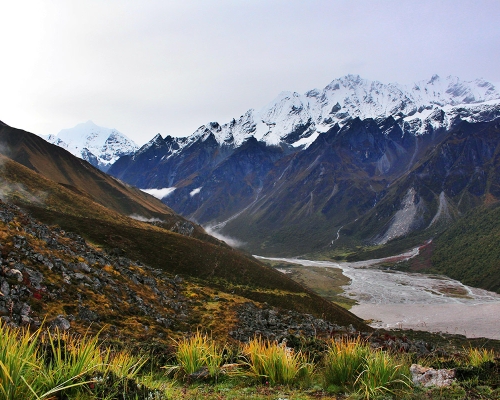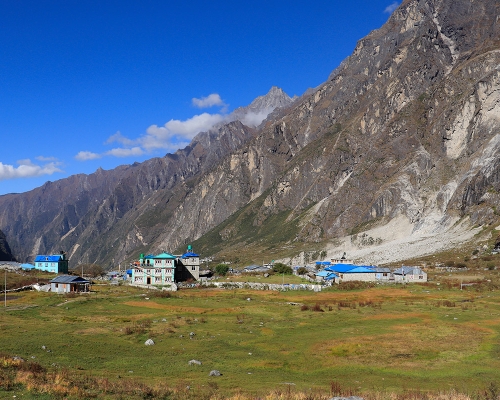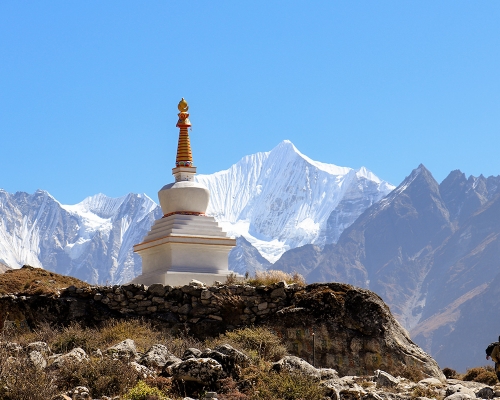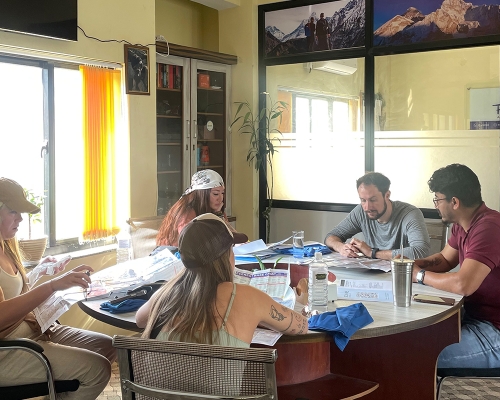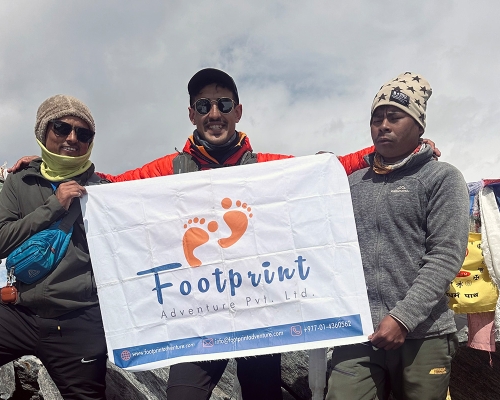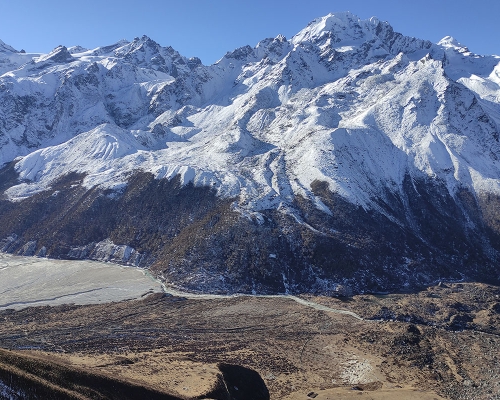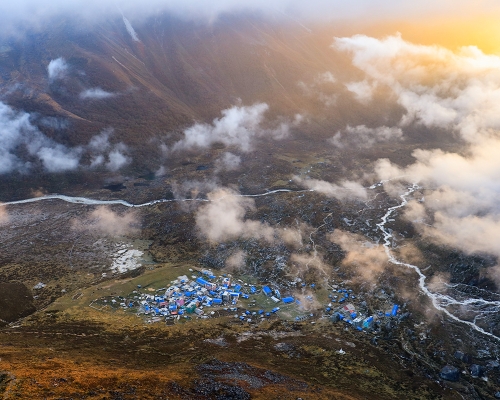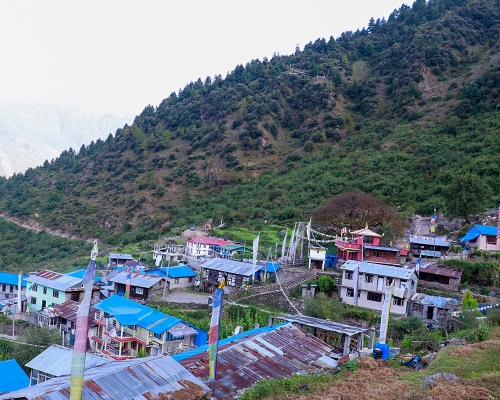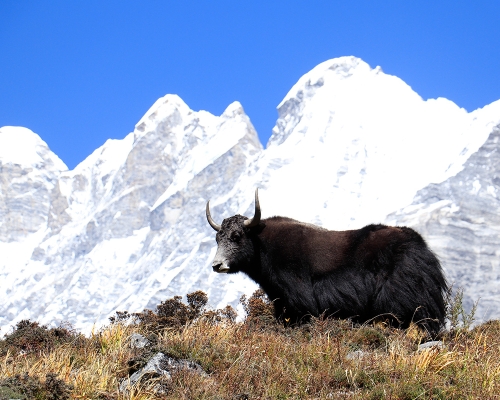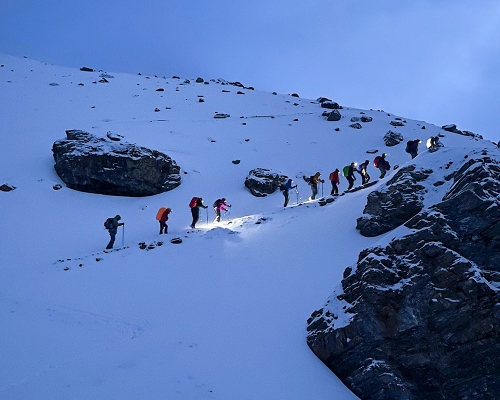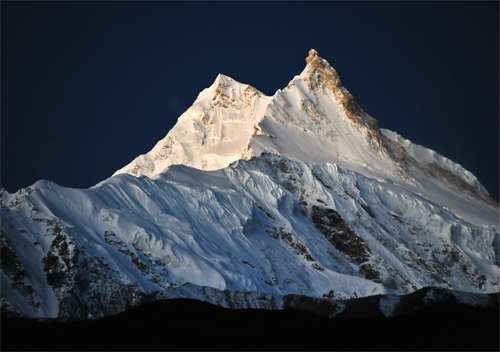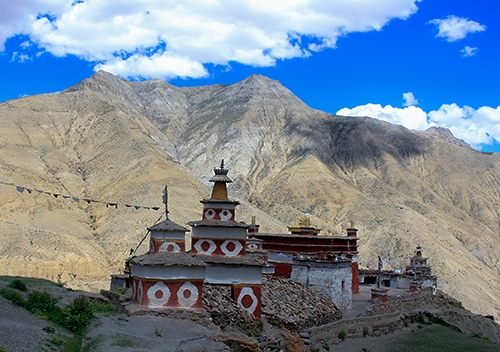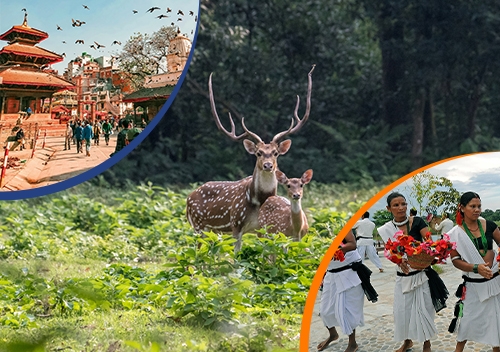Nestled in the Langtang region of Nepal, Yala Peak stands tall at an elevation of 5,500 meters, offering a breathtaking view of the majestic Himalayan range and is one of the easy climbing route in Nepal. Yala Peak climbing is a perfect destination for novice mountaineers who seek an unforgettable adventure that combines breathtaking scenery, cultural experiences, and a challenging climb.
Yala Peak is a climbing mountain in the Langtang region that is covered in snow. It is a fairly easy climb that doesn't require any special skills. TheNepal Mountaineering Associationcalls it a trekking peak. During Yala Peak climbing, the Shishapangma (8013 m), the tallest mountain entirely in Tibet, and 14 other mountains with elevations over 8000 m may be seen from the summit of Yala Peak, which is distinguished for being a magnificent vantage point. Aside from hiking, Yala Peak climbing in Nepal offers the most exciting adventure hiking and peak climbing in the Langtang region. Yala Peak, at a height of 5,500 meters, is a safe way for climbers without any prior experience to get their first taste of an alpine peak, at least in the Himalayas.
The journey to the base camp starts from Syabrubesi, which is a 7-8 hour drive from Kathmandu. From there, the trail leads through the Langtang Valley, where you can see the Langtang Lirung and other peaks, and then continues to Kyanjin Gompa, a Buddhist monastery and village at an altitude of 3,850 meters. Kyanjin Gompa is the last stop before the final climb, where you can acclimatize and prepare for the ascent. The ascent to Yala Peak starts early in the morning from Kyanjin Gompa, and the climb takes about 5-6 hours. The first part of the climb is a steep hike through rocky terrain and scree slopes, and the last part is a technical climb with fixed ropes, ice axes, and crampons.
The summit of Yala Peak offers an unparalleled view of the Himalayan range, including Langtang Lirung, Dorje Lakpa, and Ganesh Himal. Climbing Yala Peak Nepal is not only a physical adventure but also a cultural experience. The Langtang region is home to the Tamang people, who have a distinct culture and tradition. Along the way, you can visit their villages, witness their traditional dance and music, and try their local cuisine.
Yala Peak can be safely ascended by any physically healthy individual. Only an additional 700 meters must be scrambled in order to reach the summit, and it is pretty simple. Yala Peak is the shortest trekking peak in Nepal. It can be reached at a pace that allows for proper acclimatization. There are fewer tourists here because the Langtang Valley is not as well-known as Everest or Annapurna. Since the Langtang Valley goes all the way up to the border with Tibet, you can see a culture that is heavily influenced by Tibetan history and geography.
The Langtang Valley is bordered to the north by peaks reaching about 6,500 meters and to the south by a lesser range of 5,000–6,000 meters. In the northern range, Yala Peak is located. The Yala Peak climbing route begins in Syabrubensi (1,505 m), after a breathtaking 9-hour trip via the winding Trishuli River gorge. Subtropical forests are where the walk begins, but as it ascends higher into the Langtang Valley, the forests become sparser and the valley opens. On the second day, as you get closer to Langtang Village (3,300m), you can see the massive Shishapangma (8013m), Tibet's sole 8000+ meter mountain, as well as Langtang Lirung (7,246m), Lenpo Gang (7,083m), Dorje Lakpa (6,990m), and Langtang Lirung (7,246m).
The trail's final town, Kyanjin Gompa (3,970 m), the location of a former Buddhist monastery, is reached on the fourth day. Numerous chortens line the path, and it is customary to follow them to the right. If we take an extra day to get used to the altitude, we can visit the Langshisa glacier or climb to Kyanjin Ri (4,350 m) for even more breathtaking views of the snow-capped mountains. There are stunning panoramas along the way as well as a moderately challenging trail that leads to Yala Peak base camp (4,800 m). The stony south face of Yala Peak and the Yala Glacier on the southwest face are both visible from just above base camp. We set up our summit pitch from Base Camp, which is more challenging when there is snow. The trail climbs to a ridge of rocks before descending and climbing steeply again over stones. Before the final 40 meters of a sheer snow and rock cliff that leads to the short summit ridge, there is a flat region.
Highlights of Yala Peak Climbing
- Beginner friendly summit for mountaineers
- An incredible journey across the Langtang Valley.
- Trek with our knowledgeable local Sherpa guides.
- Explore Tibetan traditions and culture.
- Awesome Yala Peak peak-climbing experience
- Scenic and adventure drive to Syabrubesi, Rasuwa.
- Trekking in the Langtang Valley means trekking in the valley of glaciers.
- Experience the local Tamang & Sherpa people and their culture, practices, and traditions.
- Amazing views of valleys, alpine forests, glaciers, and rivers.
- Many rare animals live there, including the Red Panda, Snow Leopard, Himalayan Monal, and Black Bear.
- Explore the ancient Kyanjin Gompa village, monasteries, stupas, and correspondence of Buddhism.
- Panoramic views of mountains, valleys, and glaciers from the popular viewpoint of Tserko Ri.
Major Highlights of Yala Peak
Langtang Valley
Langtang Valley is a narrow mountain valley nestled with the Himalayas, and its snowy peaks provide breathtaking views of the surrounding mountains. The Himalayan scenery you will see from here is of the mighty Langtang Lirung (7,246 m), which is the highest peak in the area and is located just to the north of Langtang Valley. Along the valley, you will also see non-stop scenes of other smaller peaks filled with snow: Ganjala Pass (5,122 m), Gang Chhenpo (6,388 m), Naya Kangri (5,846 m), Dorge Lakpa (6,989 m), the Chinese Danda (ridge), Jugal Himal, and so forth. The Langtang valley is surrounded by these lofty Himalayas. These greater scenes impart amazing pleasure and are full of fondness. For deeper insights into the trek routes and highlights, be sure to check out the complete guidebook for the Langtang Valley Trek.
Kyanjin Ri
Kyanjin Ri is a famous viewpoint to look out over the Langtang Valley. The off-the-beaten-path Langtang Valley trek begins at Kyanjin Ri. On this trek, you'll spend at least two days in Kyanjin Gompa, where you can see the valley, sunrise/sunset, and mountains. Kyanjin Ri is the greatest place to enjoy Langtang's peaks. From Kyanjin Ri, you can watch the sunrise and sunset over snow-capped mountains. Kyanjin Ri's best feature is its bird's-eye view of glacial lakes, glaciers, Kyanjim Gompa, monasteries, and gorgeous valleys.
Is The Yala Peak Climb the Right Choice For You?
Yala Peak (5,500m) is an ideal option for a nice non-technical climb in Nepal for those looking for a beginner climb. It is generally regarded as easier than both Mera Peak and Island Peak. Yala Peak is non-technical, which makes it suitable for beginner and intermediate climbers. If you have reasonable fitness, some trekking experience, and are accustomed to acclimatizing to high altitudes, you can complete this moderately difficult climb with confidence.
When is the Best season for Yala Peak Climbing?
The Yala Peak Expedition is best during the spring (March to May) and fall (late September to late November) seasons. These are the busiest times for tourists, so there may be some traffic on the roads. In the winter months (December to February), when the weather is crisp and chilly, and the vistas of the mountains are crystal clear, it may be preferred by some who want to avoid crowds and climb Yala Peak. Winter is also a terrific time to climb if you are well-prepared for the cold.
How Fit Do You Need to Be for Yala Peak Climbing?
The valley trek is easy and delightful, excellent for hikers and walkers. Altitude is a concern, but the timetable allows for respite and acclimatization. Getting to base camp may require crossing the snowline, although the terrain isn't too steep. Climbing Yala Peak requires both physical and mental endurance, as well as proper training, equipment, and experienced guides. The climb usually takes about 10 to 12 days, and the trek to the base camp is equally exhilarating. Along the way, you will pass through lush forests, picturesque valleys, and quaint Himalayan villages, where you can witness the local culture and customs of the Tamang people.
From base camp, the trail goes up easy-angled snow slopes. We'll need crampons, an ice axe, and a man rope for the remaining 700 meters of steep ice. General fitness helps because high altitude requires more effort. You'll be carrying a daypack, so train with anything on your back at home. A consistent but not excessive pace requires good breathing. Long diaphragmatic breaths instead of gasping will help your body use less oxygen. With good coordination, rope climbing at altitude is safe and manageable.
How Difficult is Yala Peak Climbing?
Yala Peak is one of the simplest peaks to climb in Nepal. Any fit person can climb Yala Peak. The climb to the summit is primarily scrambling over rough terrain. The trail ascends steeply from Kyanjin Gompa to Tsergo Ri. From here, the trail splits off to the left and goes up to Base Camp, where we pitched our tent. The next day, the journey begins bright and early in the morning when the trail begins its ascent through the rugged and rocky terrain on its way to the peak of Yala, which is our ultimate target.
Climbing Yala Peak is the adventure of a lifetime that offers a perfect combination of natural beauty, cultural experience, and a challenging climb. It is an excellent option for novice mountaineers who want to test their limits and experience the thrill of scaling a Himalayan peak. With proper preparation, training, and experienced guides, Yala Peak can be conquered, and the summit view will be etched in your memory forever. This is the shortest trekking peak in Nepal, which Footprint Adventure frequently organizes.
If you are interested in learning more about this package, feel free to contact our expert team.
Why Choose Footprint Adventure for Yala Peak Climbing?
We are a local travel agency with many years of experience in trekking and climbing in the Himalayas of Nepal. We advocate for sustainability and minimizing carbon footprint with our Carryme bags to mitigate trail waste following the "Leave No Trace Principles".
Our team is always available 24/7 to personalize the package to your needs. All of our guides are certified, have extensive knowledge of the local area, and are trained in first aid and mountain safety. Our company is passionate about responsible travel.
We provide safe, personalized, and well-organized trips with clear communication and a highly professional team. Our experience and commitment ensure a high success rate and proper care, even in challenging conditions.

